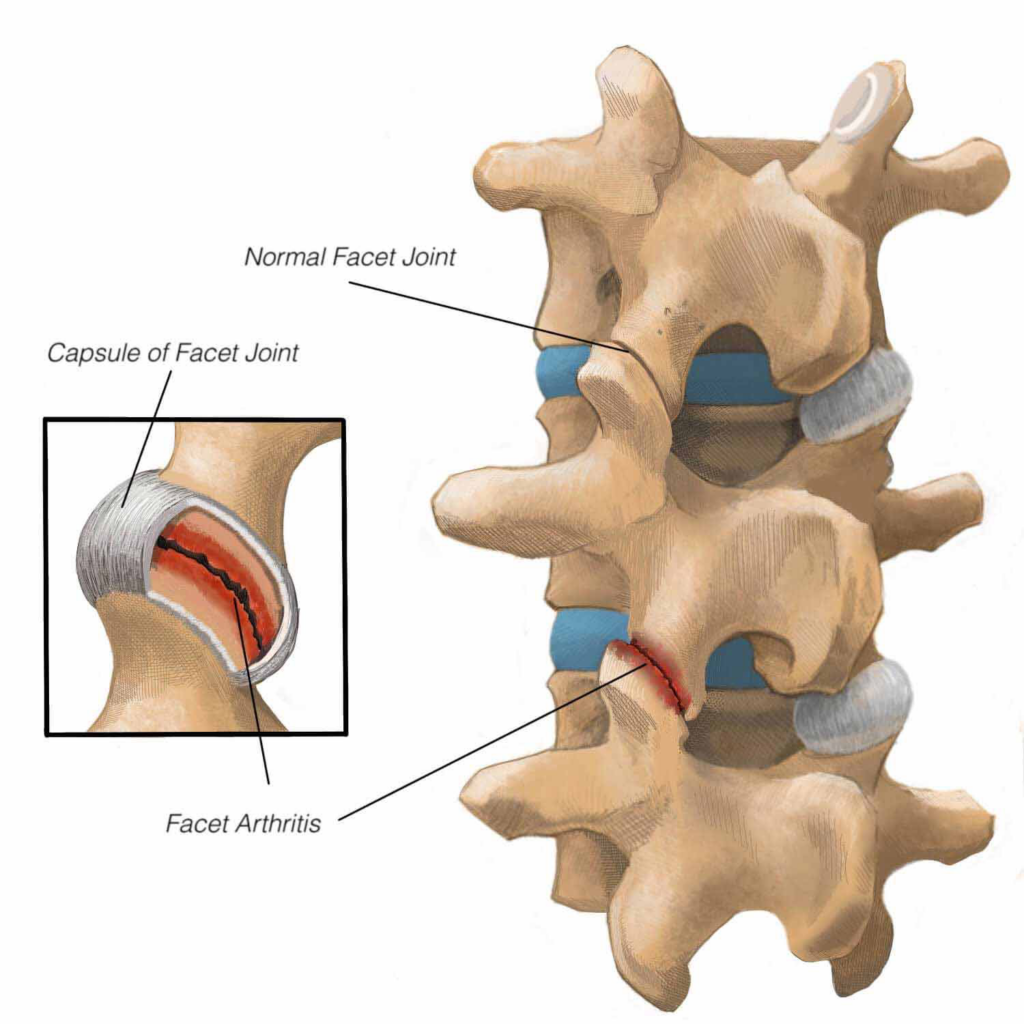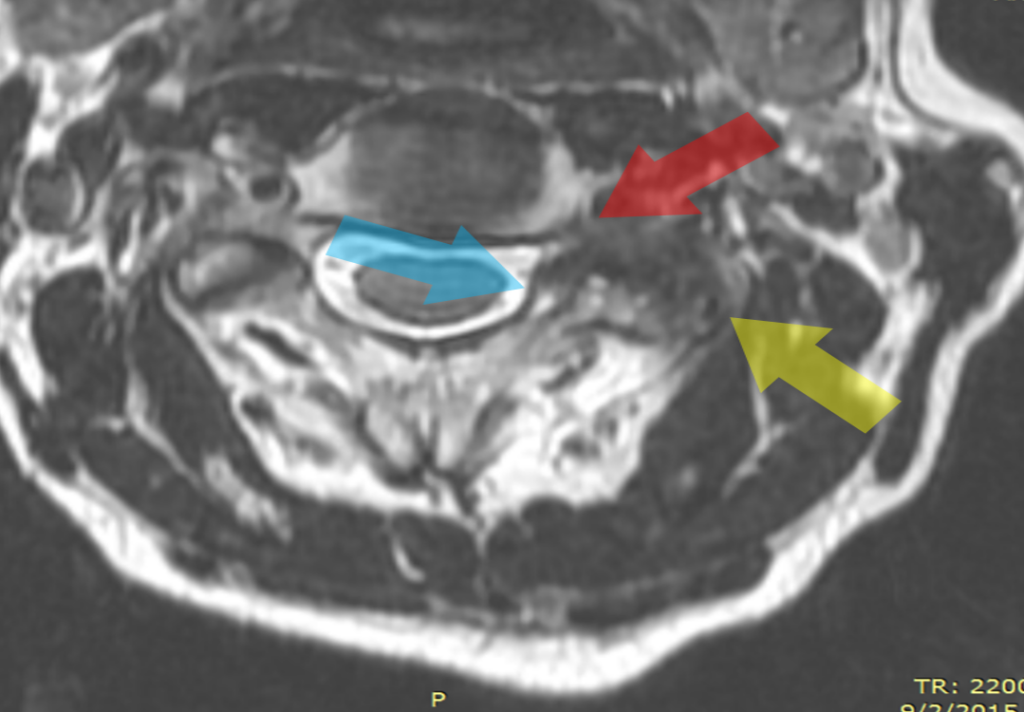What is cervical facet joint pain?
Cervical facet joint pain (also commonly referred to as neck facet joint syndrome) is one of the most common causes of neck pain. The facet joints are small joints at the back (posterior aspect) of your spine, and are prone to injury, inflammation and degeneration.
Neck pain can be especially debilitating as it often radiates into the shoulders and upper back, and may be accompanied by other symptoms such as headaches, muscle spasm, and feelings of numbness or tingling in the arms or hands.
Facet joint syndrome can occur anywhere in the spine, but is especially common in the neck (C2-C7) and lumbar spine.

The spine is complex; like other joints in the body, each facet joint is surrounded by a joint capsule which produces a lubricating fluid (synovial fluid) to nourish the joint and ensure frictionless movement.
The bony joint surfaces are coated with articular cartilage (a tough layer of tissue) that enables the bones to move smoothly against each other.
The intervertebral cervical discs act as shock absorbers and reduce the impact going through the neck.
There is also a network of muscles, ligament and tendons that attach onto the cervical spine which provide both stability and allow functional movement.
The cervical spinal nerves exit the spine just above the facet joint at each level, and provide sensory and motor control to the upper parts of the body. These can also be affected if there is a problem with your facet joints.
What causes facet joint syndrome?
There are a number of potential causes of facet joint syndrome; a facet joint can become painful and inflamed due to cartilage degeneration (age related wear and tear which causes a thinning of the cartilage), repetitive movements, poor posture, sports injuries, or spine diseases/disorders.
The cervical facet joints are working and moving almost all the time to control and stabilise the neck. Problems affecting the joints can either cause movement to be restricted or for the joint to have too much movement; both of which lead to pain and inflammation.
Facet Joint Degeneration
This is the most common cause of cervical facet joint pain; degeneration is really just the natural ageing process, causing deterioration of the joint cartilage, which adds increased stress and strain on the facet joints. Small areas of extra bone can also develop around the facet joints (bone spurs), which cause further joint irritation and inflammation, and in more severe cases, can also compress or irritate the cervical spinal nerves.

Trauma/Injury
If you suffer an injury to the spine from a fall or sports injury, this can cause a level of trauma to the facet joints by overstretching the ligaments and causing small tears in the joint capsule. This can lead to hypermobility (too much movement) of the joint.
Degenerative Disc Disease
When the intervertebral disc is damaged (usually by wear and tear), its shock absorbing properties are deduced. Without this spongy cushion protecting the vertebrae, the joint space between the facet joints also becomes less, which places added stress on the facet joints.
Osteoarthritis (Spondylosis)
If facet joint and disc/cartilage wear and tear continue over time, this can lead to osteoarthritis of the spine, or Spondylosis as it is also known.
Poor posture
Sitting, standing or moving with poor spinal posture can also cause undue stress on the facet joints. If the natural curve of the spine is not maintained, it can put excessive stress on the cervical facet joints. This is seen a lot with people who work for long hours at a computer or play computer games for long periods.
Spinal Disorders
Less common spinal disorders or diseases such as rheumatoid arthritis or ankylosing spondylitis, can affect the cervical facet joints.
Risk Factors of Cervical Facet Joint Pain
- Obesity – being overweight can put more pressure on the joints in the spine
- Playing contact sports such as rugby or wrestling
- People who have manual jobs involving repetitive bending or hyperextension of the neck – electricians, plumbers, painters and decorators.
- People who work long hours at a computer – especially if their workspace is not set up correctly.
Trauma to the cervical spine - Age – Pain caused by facet joint degeneration is more common in people over 40. Pain caused by trauma, overuse, or an overstretch of the joint is more common in people under 40.
- If you suffer from degenerative disc disease, you are more likely to have facet joint syndrome.
- Poor spinal posture or spinal deformity
What are the symptoms of Cervical Facet joint pain?
Cervical facet joint syndrome can present with a variety of symptoms depending on the location and the severity of the injury or degeneration.
Symptoms often initially appear as short, sporadic episodes, however these can quickly become more regular and severe if left untreated.
In most cases the pain is fairly localised to the neck initially, but if there is muscle spasm or if the nerve root is also affected, the pain and symptoms can radiate into the shoulders, upper back and even down the arm to the hand.
Common symptoms include:
- Localised neck pain at the level of the affected joint/joints
- Diffuse soreness and/or stiffness in the neck – difficulty turning your head from side to side or up and down.
- Headaches – often located at the back of the head.
- Muscle soreness or spasms in the neck muscles.
- A feeling of weakness in the arm, wrist or hand
- Pain between the shoulder blades or upper back
- Tingling, or pins and needles sensation in the arm and hand
- Tenderness on palpation at the site of the inflamed facet joint
In most cases only one side of the facet joint or joints are affected, although it is possible for the problem to occur bilaterally (on both sides).
The symptoms of cervical facet joint pain can mimic other cervical spinal conditions, therefore it is very important to see an experienced healthcare professional to get an accurate diagnosis.
If you have any of the above symptoms or are concerned that you have a facet joint injury then please get in touch with us at Complete, to book an appointment.
How is Cervical Facet joint pain diagnosed?
In most cases a diagnosis of cervical facet joint syndrome is primarily made based on the patient’s symptoms, a good medical history of and thorough physical examination.
Using their professional skills, your Physiotherapist at Complete will assess each level of your spine and confirm the specific facet joint that is causing the problem, and whether it is locked, stiff or unstable.

Your spinal physiotherapist, will expertly assess your neck; the physical examination will likely include assessing:
- Range of movement of your neck, shoulders and thoracic spine
- Muscle strength of your neck, back and arms
- Sensory impairment
- Upper limb reflexes
- Spinal posture
- Cervical spinal stability
Imaging studies are not usually required, however scans such as X-ray, CT, or MRI, may be ordered if your therapist suspects there may be other spinal issues, or to assist with a more complex diagnosis.

MRI showing degeneration and inflammation of the facet joint.
If your Physiotherapist feels that you need a scan, they will be able to refer you to a specialist spinal consultant or clinic.
How is Cervical Facet Joint Pain Treated?
Complete Physio has gained an excellent reputation amongst patients and peers for providing a highly specialised clinic for those suffering with spinal conditions. We are trusted by some of the most highly regarded spinal surgeons and sports medicine consultants in the country, to treat their patients.
Mechanical neck pain should always be treated conservatively as a first line of action.
Your physiotherapist at Complete will provide you with a tailored regime based on your symptoms and personal goals. This will often include:
Patient education
We will ensure that you have a clear understanding of your condition and what will be required to progress and optimise your recovery.
Pain Management
Initially your treatment will focus on reducing your pain, in order to allow you to better engage in physiotherapy. Being more pain free will also enable you to move more normally and will have a positive effect on your sleep – which is vital for tissue repair and healing.
Medication
The most common kinds of medications prescribed to help control symptoms of facet joint pain include painkillers, nonsteroidal anti-inflammatory drugs, and muscle relaxers. You should always seek medical advice before taking any medication.
Soft Tissue Therapy
Massage is incredibly useful to help reduce muscle spasms and tension in the neck, it also has relaxation benefits.
Ice and Heat
Depending on the cause and nature of your pain and symptoms, Ice can be used to reduce pain and inflammation, whereas heat can help with muscle spasms and joint stiffness. Your therapist will advise you on the best option for you.
Acupuncture or Dry Needling

Acupuncture for neck pain has been used for thousands of years to help with both pain and muscle spasm.
Movement and Muscle Strength
Once your pain has settled, the next phase is to work on regaining your movement and muscle strength.
Range-of-movement and Stretching Exercises
Your physiotherapist will teach you stretching exercises for your neck joints and muscles. These can decrease tension in your neck and help restore normal motion of your cervical spine.
Joint Mobilisations and Manipulations

Your physio will also likely do some ‘hands on’ joint mobilisations to your facet joints and cervical vertebrae. This will work on any localised facet joint stiffness or locked joints.
Muscle Strength and Stability
Muscle imbalances and weakness in the muscles of the neck and spine can cause or contribute to problems with cervical facet joint pain. Your physiotherapist will design a safe resistance program to ensure all your muscle groups are strong and working in synergy. They will focus on very specific exercises that target the deep neck muscles which dynamically control and stabilise your neck.

You will also work on global strength of your core, back and upper arms, to help offload the pressure on your smaller neck muscles and give you maximum strength and stability throughout your spine.
Posture Re-education
Your physiotherapist will work on your posture and correct any abnormal movement patterns. They can also carry out an ergonomic assessment, if your symptoms are aggravated by sitting at work.

Your physiotherapist may also suggest that you commence a course of Pilates, which is a highly effective way of managing more chronic cervical spine pain and improving posture.

Restoring Full Function
Once your pain, strength, and range of movement improve, functional training can help you safely resume more demanding activities. Depending on your occupation, or chosen sport or activities, your physiotherapist will tailor your rehabilitation to work on specific functional movements or tasks, to allow you to return to your desired activities safely.

At Complete Physio we are experts at the treatment and management of facet joint pain. We are dedicated to getting our patients out of pain and back to full function.
Cervical Facet Joint Injections
This procedure is a minimally invasive intervention wherein a combination of numbing medication (anaesthetic) and corticosteroid (also referred to as cortisone or steroid) is injected. There are two objectives when using facet joint injections; to confirm a diagnosis and to deliver extended pain relief.
When anaesthetic is introduced into the facet joint to alleviate, it serves as a diagnostic tool to establish whether the facet joint is indeed the source of the pain. In tandem with the anaesthetic, corticosteroid (cortisone) is also used to mitigate inflammation, potentially offering longer-term pain relief .
The duration of pain relief resulting from these injections can vary, spanning from a few weeks to multiple years. Should pain recur, the procedure can be repeated.
If your Physiotherapist feels that this is the best treatment route for you, they will refer you to a trusted spine or pain consultant who can administer these injections.

Injections should not be used as a stand alone, or first line treatment. Once your pain has settled from the injection (approx 1 week), you should re commence your rehabilitation under the guidance of your Physiotherapist at Complete.
Surgery for Cervical Facet Joint Pain
Only in extremely rare situations is immediate surgery required for facet syndrome; it is usually only performed as a last resort. The goal of surgery for facet syndrome is to relieve pain, stabilise the cervical spine, and promote a person’s mobility and quality of life.
Don’t let pain hold you back, book now!





